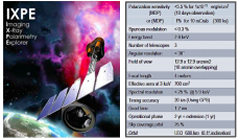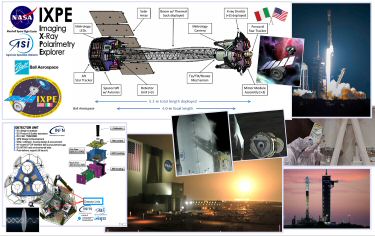IXPE Science Topical Working Groups webpage
| The NASA's Small Explorer (SMEX) mission "Imaging X-ray Polarimetry Explorer" (IXPE) is a pointing telescope exploiting the polarization state of the X-ray photons emitted by violent and dense astronomical objects (extreme gravitational, electric, magnetic fields), such as neutron stars and pulsar wind nebulae, as well as stellar and supermassive black holes. IXPE is an exclusive and bilateral collaboration between NASA and the Italian Space Agency (ASI), selected on January 3, 2017 and launched on December 9, 2021, at 6.00 UT, from the Kennedy Space Center in Cape Canaveral, Florida, USA, on board of a Falcon 9 (space X private company) rocket. The three identical X-ray telescopes and cameras onboard of the spacecraft provide imaging, energy, and timing data in the 2-8 keV band, with polarization-sensitive detectors (gas pixel detector GDP), and grazing-incidence optics for each one. The IXPE science team has a very long history in X-ray polarimetry (theoretical studies and first measurements in early '70s). |  |
|
• IXPE @ NASA - info, press releases, public outreach web |
|
Technical and science objectives:
• improving polarization sensitivity by two orders of magnitude over the X-ray polarimeter onboard OSO-8; |
